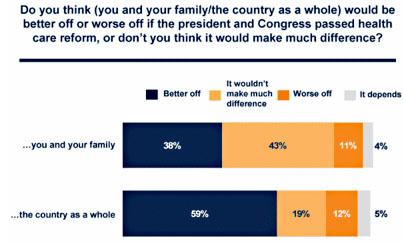 Ezra Klein talks about the healthcare principles outlined in Obama’s budget:
Ezra Klein talks about the healthcare principles outlined in Obama’s budget:
The salient fact about health insurance in the United States is not that 15 percent don’t have it. It’s that 85 percent do….That’s why the first three health care principles in Obama’s budget speak to the concerns of the insured: Choice, affordability, security. But In his latest column at the Kaiser Family Foundation, Drew Altman suggests a metric we should we be watching to see if they’re successful. Polls, he notes, generally ask whether you think health reform will make your family better off. Kaiser recently ran one such survey and the results were moderately encouraging.
At a guess, it’s the group in the center that’s critical. Supporters provide the shock troops and the opposition provides, um, the opposition. But that big middle group that mostly thinks national healthcare is probably good for the country but isn’t sure if it’s good for them? They’re the ones most easily swayed by conservative scare talk. Altman notes that these poll numbers are better than the ones Bill Clinton enjoyed in 1993, which is good, but 43% is still a huge number. That’s the battleground.

















